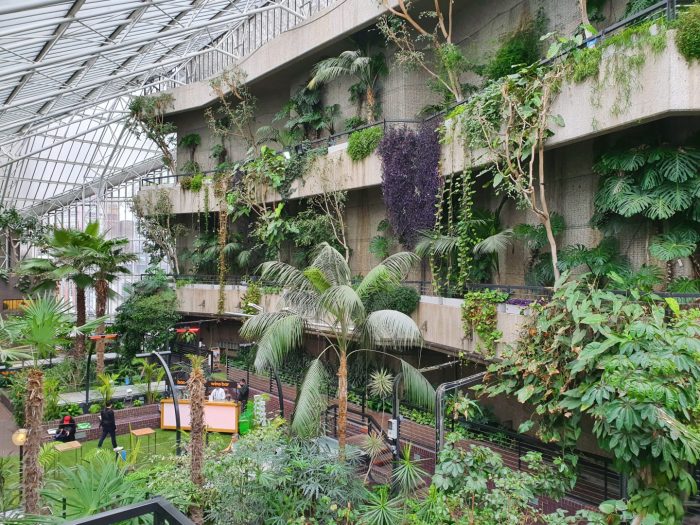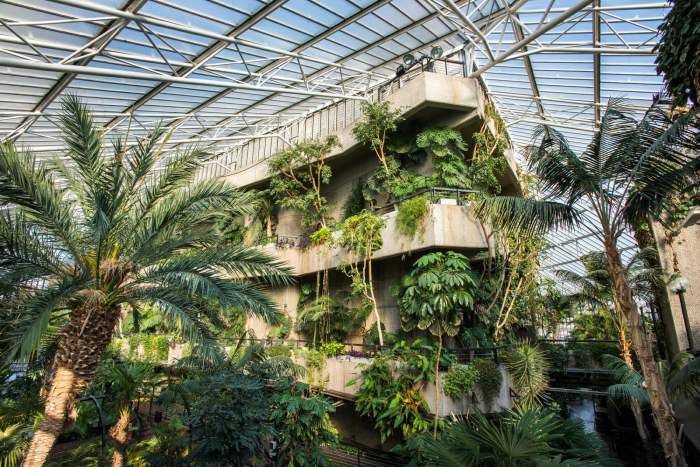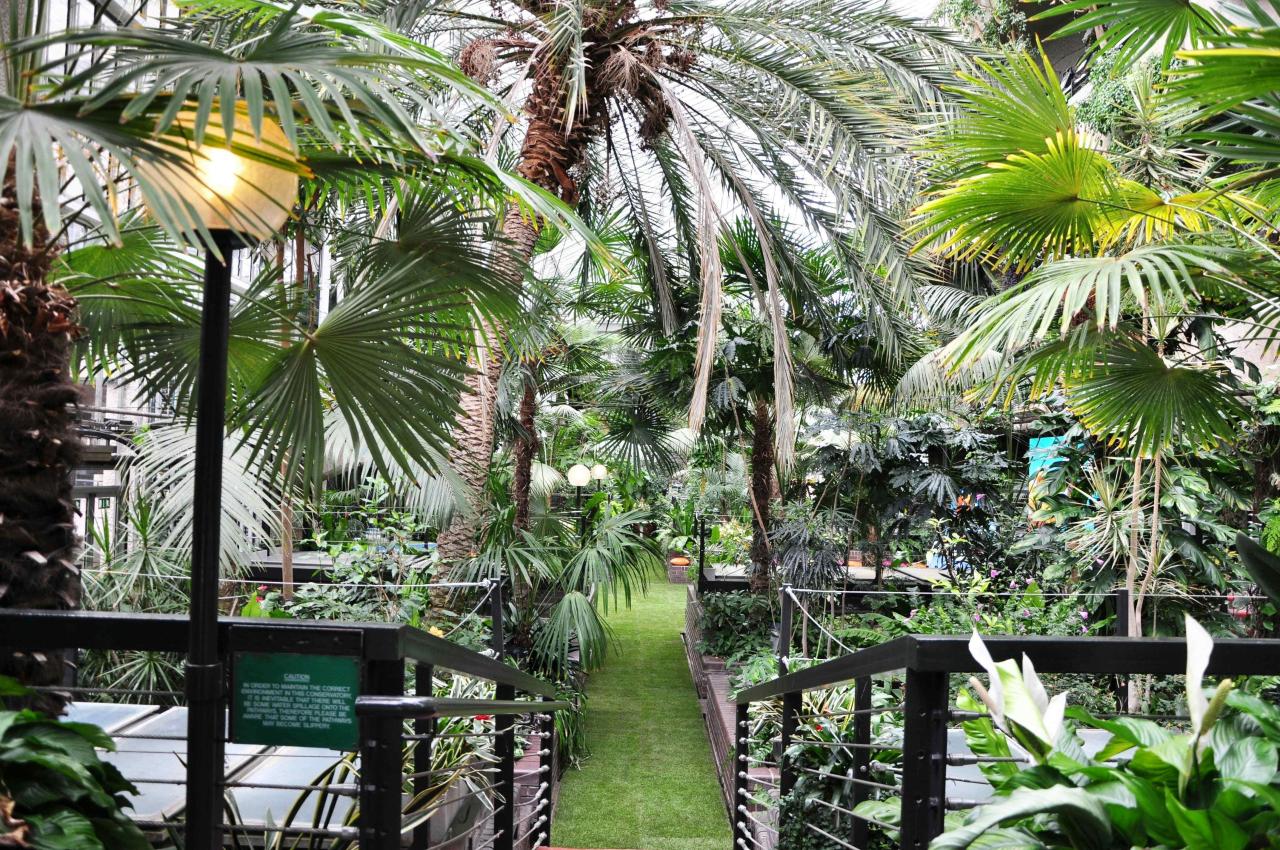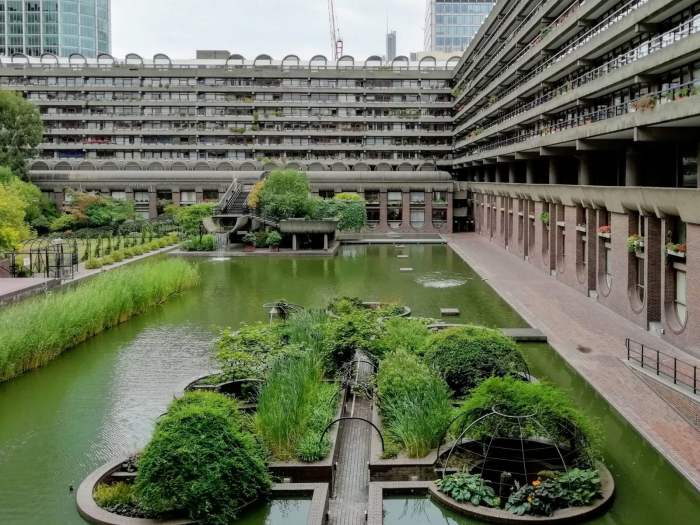The Barbican Conservatory, a captivating botanical haven nestled within the Barbican Centre, beckons you on an extraordinary journey through the world of horticulture and architectural brilliance. Step inside its glasshouse sanctuary and immerse yourself in a verdant tapestry of tropical wonders, where nature’s artistry unfolds in breathtaking splendor.
This iconic conservatory has become a beloved destination for nature enthusiasts, art aficionados, and anyone seeking respite from the urban bustle. Its unique design, diverse plant collection, and engaging programs have earned it a reputation as a cultural landmark and a vibrant community space.
Barbican Conservatory Overview

Nestled in the heart of the Barbican Estate, the Barbican Conservatory stands as a testament to the visionary architectural legacy of the post-war era. Completed in 1984, this iconic glasshouse was conceived by architects Chamberlin, Powell, and Bon, renowned for their innovative approach to urban planning and design.
The conservatory’s distinctive structure comprises a series of interconnecting glasshouses, creating a microcosm of diverse tropical environments. Its soaring glass walls and steel framework allow for an abundance of natural light, fostering the growth of an exotic collection of plants from around the globe.
Architectural Significance
The Barbican Conservatory is a masterpiece of modernist architecture, embodying the principles of transparency, functionality, and integration with nature. Its glasshouse design allows visitors to immerse themselves in the lush greenery, blurring the boundaries between the indoor and outdoor spaces.
The conservatory’s geometric form and modular construction reflect the Brutalist architectural style prevalent in the Barbican Estate. The exposed concrete and steel elements, combined with the sleek glass surfaces, create a visually striking and enduring architectural statement.
Role as a Cultural Landmark and Community Space
Beyond its architectural significance, the Barbican Conservatory has become an integral part of the cultural fabric of London. It hosts a variety of exhibitions, workshops, and educational programs, fostering a deep appreciation for the natural world and environmental conservation.
The conservatory serves as a vibrant community space, offering respite from the bustling city life. Its tranquil atmosphere and lush surroundings provide a sanctuary for relaxation, contemplation, and inspiration.
Plant Collection and Biodiversity: Barbican Conservatory
The Barbican Conservatory boasts an impressive collection of over 2,000 plant species from around the world. These plants showcase a remarkable diversity of forms, colors, and adaptations, contributing to the conservatory’s unique and captivating atmosphere.
The conservatory’s plant collection is meticulously organized into distinct zones, each replicating the environmental conditions of different biomes. This allows visitors to experience a wide range of plant life, from lush tropical rainforests to arid deserts.
Tropical Trees
The tropical tree zone is a towering testament to the diversity of plant life found in the world’s tropical regions. Visitors can marvel at towering palms, rubber trees, and strangler figs, all reaching towards the conservatory’s glass ceiling.
These trees play a crucial role in the ecosystem, providing habitat and food for a variety of animals. They also contribute to the regulation of the Earth’s climate by absorbing carbon dioxide and releasing oxygen.
Aquatic Plants, Barbican conservatory
The aquatic plant zone is a tranquil oasis, showcasing a variety of plants that have adapted to life in water. Visitors can observe floating water lilies, submerged hornworts, and carnivorous pitcher plants, each with unique strategies for survival in this aquatic environment.
Aquatic plants play a vital role in maintaining the health of freshwater ecosystems, providing food and shelter for aquatic organisms and helping to filter pollutants.
Exotic Flowers
The exotic flower zone is a riot of color and fragrance, featuring a dazzling array of flowers from around the world. Visitors can admire delicate orchids, vibrant bromeliads, and fragrant lilies, each with its own unique beauty and evolutionary story.
Exotic flowers play a crucial role in the ecosystem as pollinators, attracting insects and birds that help to disperse their seeds and ensure the continuation of their species.
Barbican Conservatory, with its captivating display of diverse flora, offers a tranquil sanctuary amidst the bustling city. For art enthusiasts, a visit to the nearby andy warhol museum is a must, showcasing the iconic works of the pop art legend.
Returning to the Barbican Conservatory, immerse yourself once more in the vibrant tapestry of nature, where lush greenery and exotic blooms create a captivating visual spectacle.
Conservation and Sustainability
The Barbican Conservatory is committed to conservation and sustainability, recognizing the importance of preserving the planet’s biodiversity. The conservatory works closely with botanical gardens and conservation organizations around the world to protect endangered plant species and promote sustainable practices.
The conservatory also uses sustainable practices in its daily operations, such as rainwater harvesting, energy-efficient lighting, and organic pest control. By embracing these principles, the conservatory aims to minimize its environmental impact and contribute to a more sustainable future.
Educational and Research Programs

The Barbican Conservatory serves as a hub for botanical education and research, fostering environmental awareness through engaging programs and groundbreaking scientific initiatives.
Educational Programs
The conservatory offers a diverse range of educational programs tailored to all ages and interests:
– Guided Tours: Led by knowledgeable horticulturists, these tours provide an immersive exploration of the conservatory’s diverse plant collections, highlighting their unique adaptations and ecological significance.
– Workshops: Hands-on workshops empower participants with practical gardening skills, covering topics such as plant propagation, sustainable gardening techniques, and floral design.
– Lectures: Renowned botanists and researchers share their expertise through engaging lectures, delving into cutting-edge scientific discoveries and the latest advancements in plant science.
Botanical Research
The conservatory plays a vital role in botanical research, contributing to the advancement of scientific knowledge through:
– Plant Collection and Conservation: The conservatory houses a vast and diverse plant collection, providing a valuable resource for scientific studies and conservation efforts.
– Research Partnerships: Collaborations with universities and research institutions facilitate groundbreaking research projects, exploring topics such as plant adaptation, biodiversity, and the impact of climate change.
– Plant Conservation: The conservatory actively participates in plant conservation initiatives, working to preserve endangered species and promote sustainable practices.
Environmental Awareness
The educational initiatives of the Barbican Conservatory play a crucial role in fostering environmental awareness and promoting responsible stewardship of the natural world:
– Inspiring Appreciation for Nature: By showcasing the beauty and diversity of plant life, the conservatory instills a deep appreciation for the natural world and its importance.
– Promoting Sustainable Practices: Educational programs emphasize the importance of sustainable gardening techniques, encouraging participants to adopt environmentally conscious practices in their own gardens and communities.
– Fostering Environmental Advocacy: Through lectures and workshops, the conservatory empowers participants to become advocates for environmental conservation, equipping them with the knowledge and skills to make informed decisions and contribute to a more sustainable future.
Exhibitions and Events

The Barbican Conservatory serves as a unique platform for showcasing contemporary art and design, hosting a range of exhibitions and events that complement its botanical collection.
The Barbican Conservatory is a tropical oasis amidst the urban jungle of London, showcasing an array of exotic plants from around the world. A short stroll away is the renowned Audubon Zoo , where you can encounter fascinating wildlife from Louisiana’s diverse ecosystems.
Returning to the Barbican Conservatory, immerse yourself in the lush greenery and tranquil ambiance, a sanctuary in the heart of the city.
The conservatory’s exhibitions often explore the intersection of art and nature, showcasing installations, sculptures, and artworks that engage with the surrounding plant life. These exhibitions have featured renowned artists and designers, providing a dynamic and immersive experience for visitors.
Past and Upcoming Exhibitions
The following table summarizes past and upcoming exhibitions held at the Barbican Conservatory:
| Exhibition | Dates | Artists/Designers | Theme |
|---|---|---|---|
| Nature Abstracted | March – June 2023 | Various | Exploration of abstract forms and patterns found in nature |
| Symbiotic Relationships | October 2022 – January 2023 | Anna Ridler, Studio Swine | Investigation of the interconnectedness between plants and other organisms |
| The Living Pavilion | May – September 2022 | Atelier NL | Sustainable design and the relationship between architecture and nature |
| Biophilic Design | March – June 2021 | Various | Exploration of the positive effects of nature on human well-being |
| The Botanical Mind | October 2020 – January 2021 | Alexandra Daisy Ginsberg, Cooking Sections | Interdisciplinary exhibition exploring the scientific and cultural significance of plants |
Architectural Design and Features
The Barbican Conservatory stands as a testament to innovative architectural design, boasting a unique combination of steel framework, glass panels, and advanced ventilation systems. Its structural elements and construction techniques set it apart from other notable glasshouse structures.
The Barbican Conservatory is a unique oasis within the bustling city of London. Its diverse collection of plants, including tropical and desert species, creates a serene escape from the urban jungle. After exploring the lush conservatory, why not delve into the natural wonders of the Azores Islands , where volcanic landscapes and crystal-clear waters await discovery?
Upon your return to the Barbican Conservatory, you’ll appreciate its verdant sanctuary even more.
Comparing the Barbican Conservatory to other iconic glasshouses, such as the Crystal Palace and the Eden Project, reveals its distinct characteristics:
Structural Elements
- Steel Framework: The Barbican Conservatory employs a robust steel framework that provides structural support and allows for expansive glass panels.
- Glass Panels: The conservatory features large, double-glazed glass panels that maximize natural light penetration while minimizing heat loss.
- Ventilation Systems: An advanced ventilation system ensures optimal air circulation and temperature control, creating a suitable environment for a diverse range of plant species.
Challenges and Innovations
The design and construction of the Barbican Conservatory presented several challenges, which were met with innovative solutions:
- Curved Roof: The curved roof design required complex engineering to ensure structural integrity and prevent water accumulation.
- Expansion Joints: The use of expansion joints allowed for thermal expansion and contraction, preventing damage to the structure.
- Integrated Planting Beds: The planting beds were designed to be integrated into the structure, creating a seamless visual effect and maximizing space utilization.
Visitor Experience and Amenities
The Barbican Conservatory offers a welcoming and engaging experience for visitors of all ages. Upon arrival, guests are greeted by knowledgeable staff who provide information about the conservatory’s diverse plant collection and ongoing exhibitions.
Amenities
The conservatory provides a range of amenities to enhance the visitor experience:
– Cafeteria: A cozy cafe offers light refreshments, snacks, and beverages.
– Gift Shop: A well-stocked gift shop sells a variety of souvenirs, including plants, books, and unique gifts.
– Accessible Facilities: The conservatory is fully accessible, with ramps, elevators, and accessible restrooms.
Enhancing Visitor Engagement
The Barbican Conservatory is committed to creating a memorable and educational experience for visitors. Several strategies are employed to enhance visitor engagement and satisfaction:
– Interactive Exhibits: Interactive displays provide hands-on learning opportunities, allowing visitors to explore the plant kingdom in a fun and engaging way.
– Guided Tours: Guided tours led by experienced horticulturists offer an in-depth look at the conservatory’s collections and behind-the-scenes insights.
– Educational Programs: The conservatory hosts educational programs for children and adults, including workshops, lectures, and family-friendly activities.
– Special Events: Throughout the year, the conservatory hosts special events such as plant sales, exhibitions, and live music performances.
Last Recap

As you bid farewell to the Barbican Conservatory, you will carry with you a profound appreciation for the beauty and diversity of the natural world. Its educational initiatives, thought-provoking exhibitions, and innovative design have left an enduring mark, inspiring you to embrace the wonders of botany and the importance of environmental stewardship.
The Barbican Conservatory stands as a testament to the transformative power of nature and the human spirit. May its verdant sanctuary continue to enchant and inspire generations to come.
FAQ Guide
When is the Barbican Conservatory open?
The conservatory is open daily from 9am to 5pm.
Is admission to the Barbican Conservatory free?
Yes, admission to the conservatory is free of charge.
Are there guided tours of the Barbican Conservatory?
Yes, guided tours are available for a small fee. Tours must be booked in advance.
Can I bring my children to the Barbican Conservatory?
Yes, children are welcome at the conservatory. There are educational programs and activities designed specifically for children.
Are there any special events or exhibitions at the Barbican Conservatory?
Yes, the conservatory hosts a variety of special events and exhibitions throughout the year. Check the Barbican Centre website for more information.